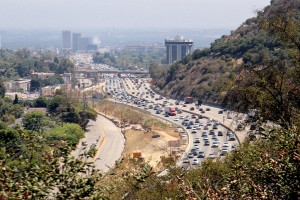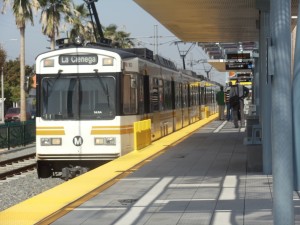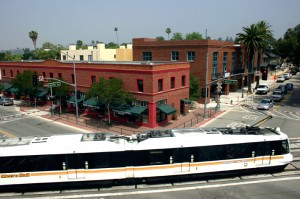The “explainer” channel Cheddar tackled why Los Angeles lost its vast streetcar network and debunks the conspiracy theory that General Motors destroyed it, featuring an interview with me:
My webinar presentation last week on the past, present, and future of transit and personal mobility in Los Angeles is now available on YouTube:
The webinar was the inaugural event for California Green Academy and Island Press‘s new Transformational Speaker Series. Stay tuned for more webinars in the series, which will focus on sustainable transportation and feature leading thinkers in sustainability, urban mobility, and innovative transportation.
 The story is fairly well known: Los Angeles used to have one of the biggest public transportation systems in the world, with the Red and Yellow trolley cars delivering people from their “streetcar subdivision” homes to the city center and beyond. But the automobile — and not an automaker conspiracy — proved more appealing to Angelenos than sitting on a crowded, tardy, and unreliable streetcar. And thus the system fell into disrepair, disuse, and extinction.
The story is fairly well known: Los Angeles used to have one of the biggest public transportation systems in the world, with the Red and Yellow trolley cars delivering people from their “streetcar subdivision” homes to the city center and beyond. But the automobile — and not an automaker conspiracy — proved more appealing to Angelenos than sitting on a crowded, tardy, and unreliable streetcar. And thus the system fell into disrepair, disuse, and extinction.
Curbed LA delves back into this history and helps dispel the myth that car companies undid the streetcars. In the piece, reporter Elijah Chiland asked me if anything could have been done to avoid abandoning the trolley streetcars in favor of the short-lived functionality of the automobile:
Elkind says the streetcar still could have been saved, but that “it would have taken some imagination and foresight on the part of the public to think, ‘what if we did subsidize this transit service? We might be able to address some of the problems that we have and make it a better service.'”
For whatever reason, that just didn’t happen. “The leadership wasn’t there and the foresight wasn’t there,” he says.
In the matter of the streetcar’s untimely demise, we Angelenos may have no one to blame but ourselves.
 Chiland asked a good question. Certainly many European cities decided not to ditch their streetcars during the post-war era, and they are now better off for it (although most American cities did abandon theirs, from Washington DC to the Bay Area).
Chiland asked a good question. Certainly many European cities decided not to ditch their streetcars during the post-war era, and they are now better off for it (although most American cities did abandon theirs, from Washington DC to the Bay Area).
But during a brief moment in the history of the rise of the automobile, Downtown Los Angeles officials experimented with ditching the automobile during peak hours. In the 1920s, they issued a short-lived ban on parking during certain daytime hours. But the public (and downtown business leaders) rebelled, and the policy was scrapped. During that time though when car parking was banned, streetcars evidently regained their prominence downtown and avoided the sometimes 60-minute delays caused by car traffic halting the trains, which had undermined rail service and contributed to its unpopularity.
So local policies on critical automobile issues like parking, as well as support for auto-oriented infrastructure, ultimately sealed the streetcars fate.
It’s too bad, because now Los Angeles is trying to rebuild much of that streetcar system at a huge cost, while also trying to retrofit existing car-oriented neighborhoods into more compact, walkable development. It’s hard to undo what’s already been done, but a growing population and demand for new housing presents the region with an opportunity to correct some of these past mistakes.
 The history of transit in Los Angeles County has too often been about parochial infighting and city feuding. It has thwarted many regional efforts to address the collective traffic and land use challenges in the region.
The history of transit in Los Angeles County has too often been about parochial infighting and city feuding. It has thwarted many regional efforts to address the collective traffic and land use challenges in the region.
This November, the story may re-appear, with southern L.A. County leaders threatening to torpedo the November sales tax measure for transportation, Measure M.
The Los Angeles Times is running my op-ed on the subject today. Here’s a snippet in response to south county residents’ concerns that they’re not getting enough out of the measure:
Residents of southern L.A. County are of course part of the greater region of Los Angeles — whether they work, visit, or shop in other parts of the county. Regional travel data from 2014 show that almost half of all peak period commutes from the Gateway and South Bay regions are bound for other parts of the county. These residents will benefit from mobility improvements throughout L.A. — not just the projects in their backyard. They’ll certainly stand to gain from some of the proposed signature projects, such as rail access to LAX and multiple countywide bus rapid transit lines.
So far the polling on the measure is looking pretty good, but with the two-thirds voter requirement, it will be an uphill battle. And that means that the measure could live or die by what voters in the southern part of the county decide on Election Day.
Yesterday we had a fascinating discussion of the respective rail transit histories of San Jose and Los Angeles at SPUR San Jose, with a bunch of high speed rail tidbits thrown in.
It was a particular pleasure to hear from Rod Diridon, who is basically the father of rail transit in Santa Clara County, from the VTA light rail line to the under-construction high speed rail (slated to come to San Jose in the next decade or so).
Some takeaways from San Jose/Santa Clara County’s rail transit history:
- County leaders achieved a 56% voter approval on a local sales tax initiative to launch rail back in the 1970s, partly in response to a prominent New York Times article calling San Jose the worst planned city in the country, partly due to the highly educated technology workers coming to the area, and mostly due to strong leadership at the local, state and federal levels.
- The local measure required public review of the system development every four years, which in practice meant a ton of outreach to the public, which in turn resulted in widespread awareness of the system and much public buy-in. Part of this process involved colorful mailers sent to everyone in the millions, which also provided good advertising and elicited more political buy-in.
- Diridon noted the importance of steady local leadership. He, Congressman Norm Mineta, and State Senator Al Alquist occupied their positions at various levels of government in the area for decades, allowing each to take ownership of the transit system and ensure that projects were built on time and on budget.
We also touched on high speed rail. Diridon chaired the High Speed Rail Authority and is a big booster. He surprised me by saying that the first segment from San Jose to somewhere around Bakersfield will make money by turning the Valley into bedroom communities. My impression is that the daily fare (up to $80 in today’s dollars, roundtrip) will be cost-prohibitive for most people living in the Valley.
In response to a question about getting rail from Union Station in Los Angeles to Palmdale, Diridon admitted that the route to Palmdale, which will add 15 minutes to the total ride, was made only because L.A. leaders like Supervisor Antonovich and Mayor Villaraigosa insisted the train stop there. Otherwise, he said, they wouldn’t have gotten the train built. It’s further evidence of the sad political compromise on the route.
In an irony though, he said the recent decision to change the route to now serve San Jose first is because of that Palmdale stop. Horse ranchers along the path from Palmdale to Burbank/San Fernando don’t want the train coming through, so they’ve created enough hassle to make the High Speed Rail Authority hold off on the Southern California section for now.
All in all, lots to learn in comparing the rail journeys of the two cities, which will one day be linked by high speed rail.
San Jose and Los Angeles are similar urban areas, despite their population differences. Both are primarily auto-oriented (with San Jose sometimes derisively referred to as “L.A. without the beach”). And both have recently sought to transform themselves into rail-oriented cities in recent decades.
Today at land use think tank SPUR in San Jose, the Honorable Rod Diridon and I will trace the history of the two cities’ urban transformation at a lunchtime talk. Mr. Diridon has a long and distinguished career in urban transportation issues in the South Bay, with a Caltrain/light rail transit station named after him just outside of downtown (we graded the surrounding neighborhood a “B” in our Next 10/Berkeley Law October report grading station neighborhoods across California).
The event is free and begins at 12:30. More information can be found here. I hope you can join.
 L.A. Metro has been hard at work cooking up a new list of big transit projects for the region, which would be funded with a new half-cent sales tax this November. The plan will be announced this Friday, but in the meantime, initial details leaked on some of the proposed projects last week, leading to this Los Angeles Times article from Laura Nelson:
L.A. Metro has been hard at work cooking up a new list of big transit projects for the region, which would be funded with a new half-cent sales tax this November. The plan will be announced this Friday, but in the meantime, initial details leaked on some of the proposed projects last week, leading to this Los Angeles Times article from Laura Nelson:
As envisioned, the plan would funnel about one-third of the $120 billion into full or partial funding for five new transit lines and at least six extensions of lines that are already built or under construction, the officials said.
The project list appears carefully constructed to gain voter support in all areas of the vast county, with rail lines, highway upgrades and other proposed improvements reaching communities as far-flung as Sylmar, Torrance, Artesia and Claremont.
That political dynamic — to spread the projects around the county to secure the needed two-thirds support — is the direct result of California’s Prop 13. It passed in 1978 and was eventually construed to require super-majorities for even local tax measures. As a result, self-help measures like a local transit tax must prioritize political benefits (i.e. geographic equity) over economic effectiveness or other needs.
I discussed this dynamic briefly in this short KPCC radio piece on Friday.
State leaders could really help regions like Los Angeles and other counties around the state if they allowed voters to reform Prop 13. Reducing the voter-approval threshold from two-thirds to 55% would not only ensure that locals could more easily raise funds for badly needed infrastructure, it could make those measures more effective by not having to please everyone and their mother.
Back in the 1970s, Los Angeles and San Francisco were at the top of the economic game for cities in America. At the time, the Bay Area was ranked first in income while Los Angeles was fourth.
But since then, Los Angeles has fallen to 25th, while San Francisco has surged, maintaining its top spot.
So what explains the difference? UCLA professor of urban planning Michael Storper and colleagues set about to examine the reasons in the new book The Rise and Fall of Urban Economies: Lessons from San Francisco and Los Angeles.
The book reads like a whodunit, but the bottom line explanation is that business leaders in the Bay Area continued to foster a connectedness and culture of innovation, while Los Angeles business leaders remained siloed and traditional (Storper’s slide show PDF here). Think Steve Jobs radicals mingling with financiers and traditional business leaders in the Bay Area.
The authors credit business organizations like the Bay Area Council for serving as collaborative, idea-sharing hubs for regional business leaders. But I also wonder if the region’s transportation links and business districts played a role. BART and the general centrality of the business districts in the Bay Area, from San Francisco’s financial district to Silicon Valley to downtown Oakland, allow professionals in the Bay Area to more easily congregate and mingle than in the more horizontally dense landscape of Los Angeles.
It’s perhaps another intangible benefit that could be achieved by Los Angeles expanding the Metro Rail network and building more offices near major transit stops.
You can see a snippet from Storper’s recent presentation at the Bay Area Council here:


